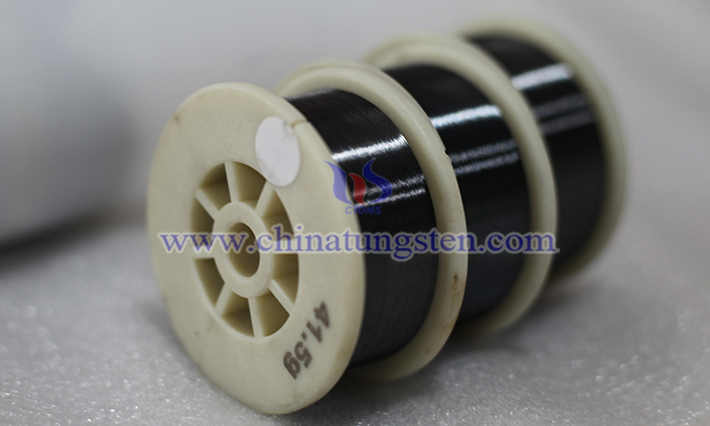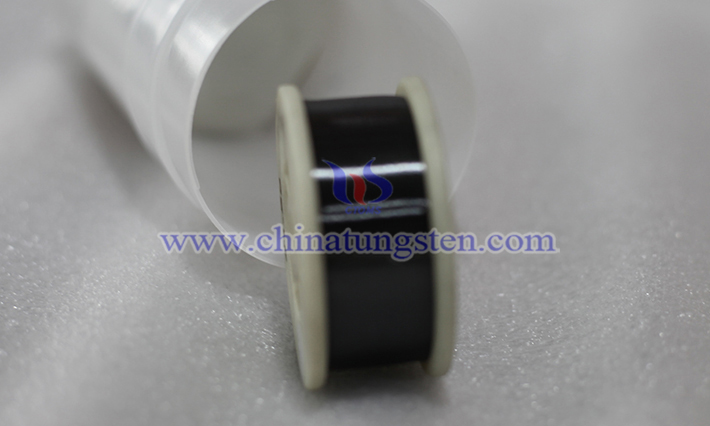Chemical Properties of Black Tungsten Wire
- Details
- Category: Tungsten Information
- Published on Wednesday, 13 August 2025 18:48
Due to its unique chemical properties, black tungsten wire is widely used in high-temperature, vacuum, and specific chemical environments. As a high-melting-point transition metal, tungsten is extremely chemically stable, but it can also exhibit some reactivity under certain conditions. The following details the main chemical properties of black tungsten wire.

1. Chemical Stability at Room Temperature
At room temperature, tungsten is extremely inert to most chemicals. Black tungsten wire does not react easily with oxygen, moisture, dilute acids (such as hydrochloric acid and sulfuric acid), or alkaline solutions. This corrosion resistance allows it to maintain its surface gloss and structural integrity for extended periods at room temperature, making it suitable for use in electronic devices or components exposed to moisture.
2. High-Temperature Oxidation
Tungsten readily reacts with oxygen at high temperatures, forming yellow tungsten trioxide (WO₃). This oxide evaporates at higher temperatures, causing surface deterioration of the tungsten wire. Therefore, black tungsten wire is often used in a vacuum or in an inert gas environment (such as argon or nitrogen) to prevent oxidation. For example, incandescent light bulbs are often filled with inert gas to prolong the life of the tungsten wire.
3. Reactions with Acids and Bases
At room temperature, tungsten exhibits good corrosion resistance to most acids (such as hydrochloric acid, sulfuric acid, and nitric acid). However, hot concentrated nitric acid or aqua regia (a mixture of nitric and hydrochloric acids) can slowly corrode tungsten, forming tungstic acid or oxides. Alkaline solutions (such as sodium hydroxide) have no significant effect on tungsten at room temperature, but high-temperature molten bases (such as NaOH) will react with tungsten to form soluble tungstates.

4. Reactions with Non-metallic Elements
Tungsten can react with certain non-metallic elements at high temperatures. For example, above approximately 800°C, tungsten reacts with carbon to form tungsten carbide (WC), an extremely hard compound commonly used in the manufacture of wear-resistant tools. Tungsten can also react with halogens (such as fluorine and chlorine) at high temperatures to form volatile halides, such as tungsten hexafluoride (WF₆), which is used in processes such as chemical vapor deposition.
5. Interactions with Metals
Tungsten can form alloys or compounds with certain metals (such as nickel and iron) at high temperatures, but its chemical reactivity is low, typically requiring high-temperature sintering or melting. When black tungsten wire comes into contact with metals under vacuum or a protective atmosphere, chemical reactions are minimal, making it suitable for use as high-temperature electrodes or heating elements.
6. Catalytic Properties
Tungsten itself does not have significant catalytic activity, but its oxides (such as WO₃) exhibit some catalytic properties in specific chemical reactions, such as photocatalysis or redox reactions. This makes tungsten and its compounds potentially useful in the chemical industry.
7. Environmental Impact
The chemical stability of black tungsten wire makes it environmentally friendly at room temperature, non-toxic, and unlikely to release hazardous substances. However, during high-temperature oxidation or pickling processes, the generated oxides or wastewater must be properly handled to avoid environmental pollution.
- Chinatungsten Online: www.tungsten.com.cn
- CTIA GROUP LTD: en.ctia.group
- Tungsten News & Price: www.ctia.com.cn
- Molybdenum News & Price: news.molybdenum.com.cn
- Tel.: 86 592 5129696; Email: sales@chinatungsten.com



 sales@chinatungsten.com
sales@chinatungsten.com